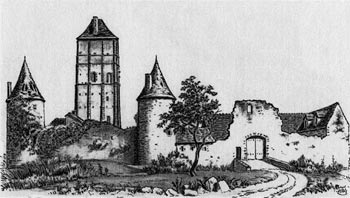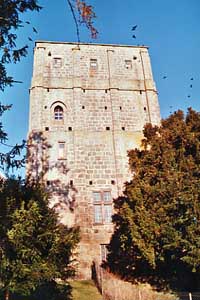|
History of the castle

Probably undertaken
by the family of Humbaud d' Huriel, the construction of this keep
starts with orée of XIIème century, the stone tower
replacing a simple constructed tower. With the improvement of the
weapons of jet, one increases first once the height of the 1st block
about the middle of XIIème century, before giving him his
final rise (24 meters with the parapet) to end in XIIème
or at the beginning in XIIIème century. A gallery out of
wooden covered - the hourd - who girdled the building with middle
height, allowed rounds and covered the foot of the wall.
In XIIIème century, one surrounds the town of ramparts, and
of the easily flooded ditches are dug around the Hat, leaving the
tower insulated on its small island, only connected to the city
by two portable bridges.
With the end of the One hundred year old war, the Hat loses its
strategic interest for the king of France: the closed city dominated
by the keep was located hitherto on the border of the county of
Walk, traditional ally of the dukes of Guyenne, kings d' Angleterre.
Jean II of Brush, lord of the places, thus decide to make his keep
more livable: it caps it with a roof with 4 sides, flanks it of
4 turrets connected between them by an enclosure to each angle and
adds dependences to him. Here is the old woman tower become pleasant
residence! This countryside doubles interior installations: one
bores the large mullioned windows, one builds the chimneys with
hoods of the stages, and a beginning of staircase between the rooms
which replaces the old system of scales.
 After
the departure in XVIème century of the family of Brush, the
Hat will know many owners, the lack of interest of the latter causing
the progressive ruin of the enclosure and the turns. From 1779,
until 1879, the ditches will be filled (because of the epidemics
that they cause), and demolished ramparts. The Municipality, new
owner of the Keep (since 1879, the classification Historic building
intervening in 1885), arrives just in time to save two of the four
turns. It undertakes with the architect Darcy, a vast restoration
campaign in 1903: the roof is demolished, and replaced by a terrace
which offers one of the most beautiful panoramas of Bourbonnais.
One builds also a turret of staircase, which makes it possible to
reach on the floors and after a rise of 105 steps, to the terrace. After
the departure in XVIème century of the family of Brush, the
Hat will know many owners, the lack of interest of the latter causing
the progressive ruin of the enclosure and the turns. From 1779,
until 1879, the ditches will be filled (because of the epidemics
that they cause), and demolished ramparts. The Municipality, new
owner of the Keep (since 1879, the classification Historic building
intervening in 1885), arrives just in time to save two of the four
turns. It undertakes with the architect Darcy, a vast restoration
campaign in 1903: the roof is demolished, and replaced by a terrace
which offers one of the most beautiful panoramas of Bourbonnais.
One builds also a turret of staircase, which makes it possible to
reach on the floors and after a rise of 105 steps, to the terrace.
One century later, the Keep always belongs to the commune, which
ensures its conservation like that of the Church Our-Lady: it shelters
a museum of the Vine and the Middle Ages in three of its rooms,
and accomodates in the two remaining rooms of the estival exposures.
The Huriel family:
The town of Huriel
takes again at the XIXème century the armorial bearings of
the family of Brush (1265-1514) in her blazon: "of azure with
three brushes or sheaves of corn of gold, dependent of mouths".
This family remained in the popular memory like most famous of the
houses seigneuriales huriéloises. The fact is explained by
the value and the reputation soldiers of some of its members as
well as the presence until the Revolution of their family mausoleum
in the old collegiate church Saint Martin d' Huriel, disappeared
today. One can always see with the museum the single vestige of
this necropolis: the lying one of Pierre Ier de Brosse, lord of
Huriel.
Among the members of this famous family, we will quote:
- Roger de Brosse:
valorous knight, it took part in the Crusade of 1248 (under Saint
Louis). One of its sons, Guillaume was a bishop of Meaux, Puy,
Bourges (from which it devoted the cathedral in 1334).
- Jean Ier de Brosse:
it was illustrated in the military career under the orders of
Jeanne d'Arc. It was present at the sacring of Charles VII in
Rheims in 1429 and at the sides of Jeanne d'Arc when this one
was done captive.
- Jean II of Brush:
man of war like his father, it illustrated himself in Normandy
with the various battles and seats which marked the end of the
one hundred year old war.
|





 After
the departure in XVIème century of the family of Brush, the
Hat will know many owners, the lack of interest of the latter causing
the progressive ruin of the enclosure and the turns. From 1779,
until 1879, the ditches will be filled (because of the epidemics
that they cause), and demolished ramparts. The Municipality, new
owner of the Keep (since 1879, the classification Historic building
intervening in 1885), arrives just in time to save two of the four
turns. It undertakes with the architect Darcy, a vast restoration
campaign in 1903: the roof is demolished, and replaced by a terrace
which offers one of the most beautiful panoramas of Bourbonnais.
One builds also a turret of staircase, which makes it possible to
reach on the floors and after a rise of 105 steps, to the terrace.
After
the departure in XVIème century of the family of Brush, the
Hat will know many owners, the lack of interest of the latter causing
the progressive ruin of the enclosure and the turns. From 1779,
until 1879, the ditches will be filled (because of the epidemics
that they cause), and demolished ramparts. The Municipality, new
owner of the Keep (since 1879, the classification Historic building
intervening in 1885), arrives just in time to save two of the four
turns. It undertakes with the architect Darcy, a vast restoration
campaign in 1903: the roof is demolished, and replaced by a terrace
which offers one of the most beautiful panoramas of Bourbonnais.
One builds also a turret of staircase, which makes it possible to
reach on the floors and after a rise of 105 steps, to the terrace.

